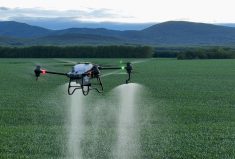Marketing your grain and using your drone have more in common than you might think.
“No one just buys a drone, flips the switch, and away it goes. You’ve got to figure out how it works and how it’s going to work for you,” said David Derwin, an investment adviser at PI Financial.
“It’s the same on the marketing side.”
Both start with understanding the tool and how you’re going to use it, said Derwin.
“You need to have that base understanding of the tool to put it into practical use,” he said. “That’s how you get value out of the whole process.”
Read Also

New crop insurer policy enables easier startup for faba beans
Agriculture Financial Services Corporation updated its normals for faba beans, which may open the door for more Canadian producers to feel comfortable growing the pulse crop in the future.
Then you need a little practice. In the case of marketing, Derwin recommends starting with something fairly easy, such as forward pricing to the elevator, before trying more advanced marketing methods such as hedging, options and futures.
“Like anything, you’ve got to get that level of comfort and confidence and understanding about how the tool works,” said Derwin.
And as with drones, information overload can be an issue.
“There’s a tremendous amount of data that drones can collect, just like there’s tremendous amount of data from the markets,” he said. “But that data isn’t all that valuable — it’s how you analyze it and develop strategies around it.”
Derwin subscribes to the saying that “a little knowledge can be a dangerous thing.”
“Some producers are just speculating more than anything else — buying and selling and buying and selling based on what’s happening in the markets,” he said.
“But if you don’t know enough to understand what’s going on in the markets, you could start trading in a way that’s not managing risk or capturing higher pricing.
“One small mistake can cost you money.”
That’s why developing a marketing strategy, with measurable marketing goals, is the way to go.
“If it’s planned out and defined ahead of time, then you’ve got certain things you’re looking for and anticipating throughout the year,” he said. “Markets do change, so that will affect your strategy, but there are certain strategies you can put in place so that when the time comes to do something, you’re ready to go.”
An investment adviser can help develop those strategies, he added.















